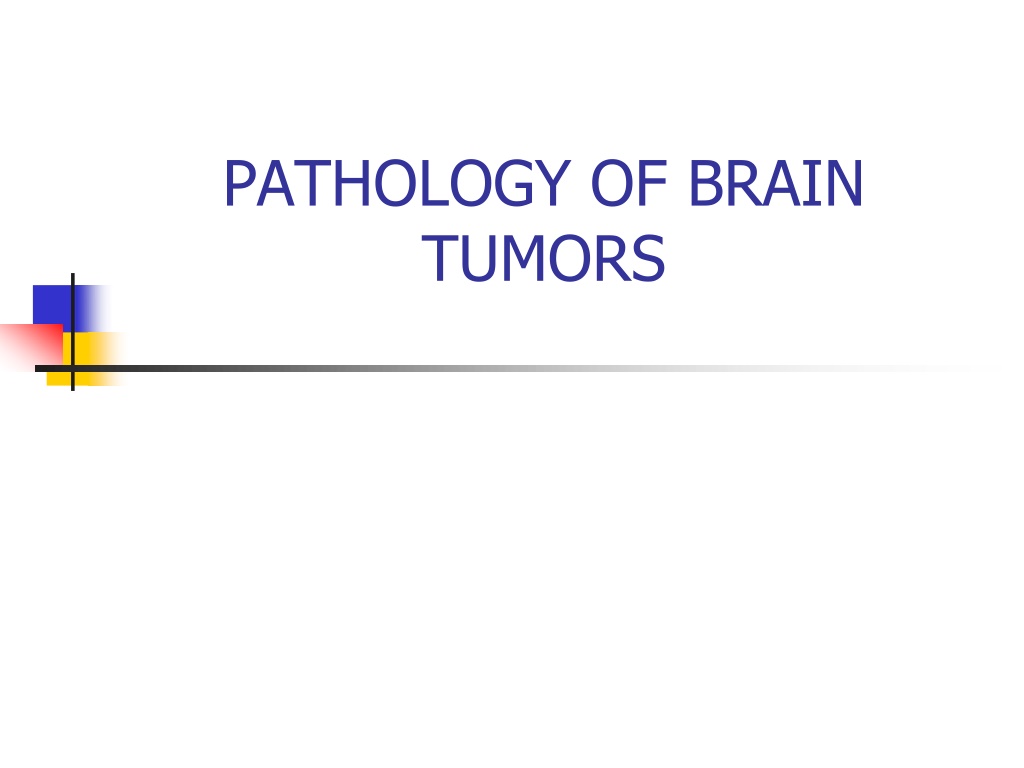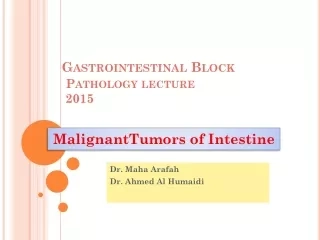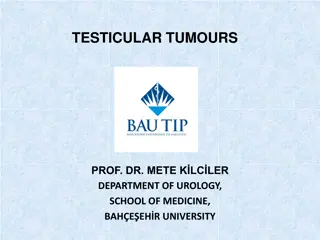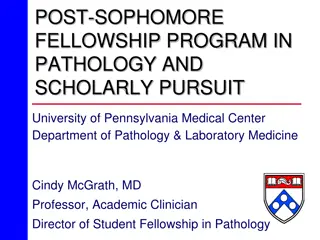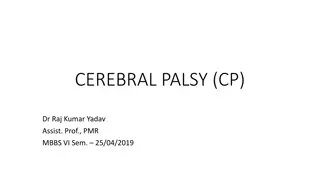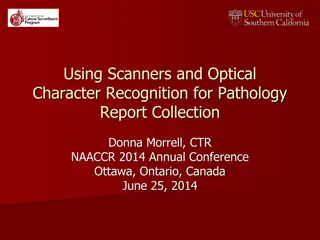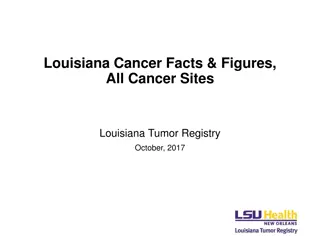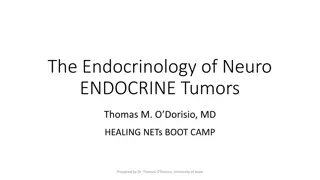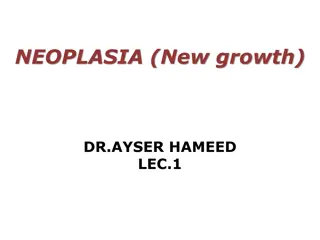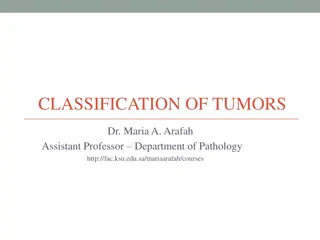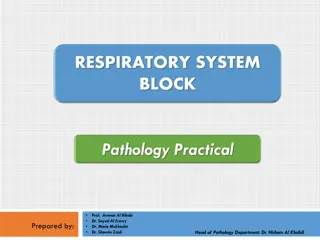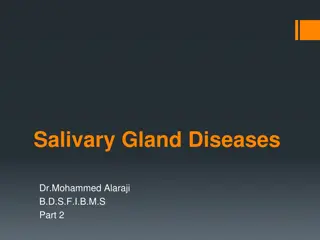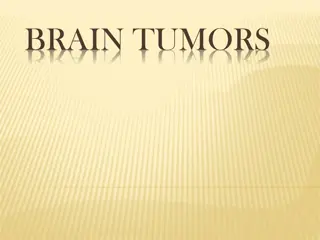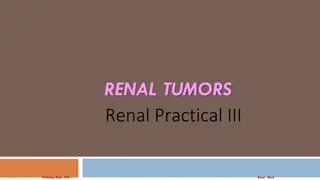Epidemiology and Pathology of Brain Tumors - Overview and Incidence Statistics
This information provides an in-depth overview of the epidemiology, classification, and pathology of brain tumors. It covers the relative incidence of various brain tumors, including astrocytoma, glioblastoma, meningioma, and others. The data also includes statistics on the occurrence of brain tumors in different age groups and highlights the significance of brain tumor pathology in diagnosis and treatment.
Download Presentation

Please find below an Image/Link to download the presentation.
The content on the website is provided AS IS for your information and personal use only. It may not be sold, licensed, or shared on other websites without obtaining consent from the author. Download presentation by click this link. If you encounter any issues during the download, it is possible that the publisher has removed the file from their server.
E N D
Presentation Transcript
PATHOLOGY OF BRAIN TUMORS
CONTENTS EPIDEMIOLOGY CLASSIFICATION PATHOPHYSIOLOGY IN BRIEF PATHOLOGY OF INDIVIDUAL TUMOR GROUPS DIAGNOSTIC APPROACH RADIOLOGICAL TUMOR MARKERS CYTOLOGY INTRAOPERATIVE FROZEN SECTION Fluorescent imaging (Chemical probe) HISTOLOGY MODERN METHODS IMMUNOHISTOCHEMICAL MOLECULAR PROGNOSTIC MARKERS
Epidemiology incidence Primary cerebral malignancy- 4 to 10/Lac general population 1.6% of all primary tumors 2.3% of all cancer related deaths Francis Ali-Osman, 2005 2nd most common cancer in children 20% of all cancers in children <15 yrs
Epidemiological incidence of individual tumor Classification Incidence / 100,000 population/yr Metastatic Astrocytoma Glioblastoma Meningioma Primary CNS lymphoma Immunocompetent Overall Medulloblastoma Germ cell tumor Pinealoma/ pineoblastoma 6 1.5 3 3 0.3 0.8-6.8 0.5 0.2 0.1 Parkin, 1997
Epidemiology comparative incidence ALL INTRACRANIAL TUMORS MENINGIOMA 12% SCHWANNOMA 6% NEUROEPITHELIAL TUMORS 34% PITUITARY TUMORS 8% VASCULAR MALFORMATIONS 3% METASTASIS 21% OTHERS 16%
Epidemiology Relative incidence at AIIMS (2002-2007) Astrocytoma 985 21% Oligodendroglioma 238 5% Others 2418 51% Ependymoma 170 4% Mixed glioneuronal tumor 72 1% Meningioma 577 12% Lymphoma 58 1% Melanoma 5 0% Embryonal type 164 3% Germ cell Tumor 23 0% Hemangioblastoma 61 1% Pineal tumors 19 0% n= 5076 patients Hemangiopericytoma 46 1% Pathology of brain tumors - Dr Amit Thapa
Epidemiology comparative incidence INTRACRANIAL NEUROEPITHELIAL TUMORS, ALL AGES PRIMARY NEUROEPITHELIAL TUMORS OF CHILDHOOD GLIOBLASTOMA AND ANAPLASTIC ASTROCYTOMA 5% PNET 6% OTHERS 9% PNET 25% ASTROCYTOMA 20% EPENDYMOMA 16% GLIOBLASTOMA AND ANAPLASTIC ASTROCYTOMA 57% EPENDYMOMA 6% OTHERS 6% ASTROCYTOMA 45% OLIGODENDROGLI OMA 5%
Epidemiological profile age wise distribution 100 90 80 70 Cerebellar hemisphere Glioblastoma Anaplastic astroyctoma Anaplastic Oligodendroglioma Metastatic carcinoma Lymphoma Other sites Meningioma Schwannoma Pituitary adenoma 60 Relative incidence 50 40 Posterior fossa Medulloblastoma Ependymoma Pilocytic astrocytoma Other sites Cranopharyngioma Chorioid plexus tumorus Cerebellar hemisphere Diffuse astrocytoma Anaplastic astroyctoma Oligodendroglioma Ependymoma Other sites Meningioma 30 20 10 0 0 10 20 30 Age (years) 40 50 60 70
Epidemiology Gender Males are more likely to be diagnosed with brain tumors than females-( 1.5:1 ) Meningiomas and pituitary adenomas are slightly more common in women than in men.
Pathophysiology of brain tumors Pathogenesis Cells of origin for most brain tumors debatable Molecular enquiries- most likely cells of origin are multipotential stem cells reside in both the developing and adult brain. Am J Pathol 2001; 159: 779-86 Genes Dev 2001; 15: 1311-33
Pathophysiology of brain tumors ONCOGENES AND CNS ONCOGENES TUMOR SUPRESSOR GENES GROWTH FACTORS sis, FGFs, CSFs, EGF, TGF Transcription factors fos, erb A, jun, myc, rel, myb, ets TRANSDUCERS ras, src, raf, mos, abl Genes Second messenger signals Active transcription complex RECEPTORS TYROSINE KINASE- erbB, fms, kit, ros, met, trk, neu GROWTH HORMONE- mpl, epo ANGIOTENSIN- mas STEROID HORMONE- erbA NUCLEUS CYTOPLASM
Pathophysiology of brain tumors ETIOGENESIS VIRUSES RNA virus- oncorna family Rous sarcoma virus, ASV, MSV, SSV DNA virus- Papovaviruses, Adenoviruses (Bovine papilloma virus, Human JC virus, SV40) NO CONCLUSIVE PROOF OF VIRAL INDUCTION OF HUMAN BRAIN TUMORS
Pathophysiology of brain tumors ETIOGENESIS RADIATION- Fibrosarcoma, meningiomas, GBM (?) True incidence unknown Criteria 1. Tumor must occur within ports of radiation therapy 2. Adequate latent period must have elapsed 3. No other predisposing factors- NF, MEN 4. Definitive tumor diagnosis 5. Rarely occur spontaneously in control
Pathophysiology of brain tumors ETIOGENESIS CHEMICAL AGENTS Methylcholanthrene pellets- 1939 Polycyclic hydrocarbons (PCHs)- gliomas (7-14 months), depending upon location Alkylating agents- most commonly used agent gliomas (oligodendrogliomas)
Pathophysiology of brain tumors IMMUNOLOGY OF BRAIN TUMORS Tumor associated- transplantation antigen, tumor specific antigen, viral antigen, fetal antigen Recognition Proliferation Effector Cellular immunity- relative suppressor dominance, balance between helper & suppressor Humoral immunity Is brain an immunologically privileged site ? Immunologic response in brain tumor Host suppression Cytokines, MHC antigen Organ and organ related antigens Cellular infiltration Mechanism of suppression and blocking
Classification of brain tumors Bailey and Cushing- 1926, first attempt to classify Bailey P, Cushing HA. A classification of the tumors of the glioma group on a histogenetic basis with a correlated study of prognosis. Philadelphia: JP Lippincott, 1926. Zulch and an international team (1979) 1st WHO classification of tumors of the CNS
Classification Primary tumors of the brain Tumors of Neuroepithelial tissue Tumors of Meninges Tumors of the sellar region Germ cell tumor Choroid plexus tumors Tumors of nerves and/or nerve sheath Cysts and tumor like lesions Other primary tumors, including skull base Hematopoietic neoplasms Metastatic brain tumors and carcinomatous meningitis
GRADING Histopathological grading Predict biological behavior of a neoplasm Clinical setting- influence choice of therapy Broder s four tiered grading- general pathology Kernohan and Sayre- 1952, graded gliomas into 1 to 4 degree of their dedifferentiation St Anne/Mayo or Daumass- Duport system- 4 grades nuclear atypia, mitoses, endothelial proliferation, necrosis
GRADING WHO classification of tumors of the nervous system includes a grading scheme - malignancy scale across a wide variety of neoplasms rather than a strict histological grading system widely used, but not a requirement for the application of the WHO classification
WHO Grading Grade I low proliferative potential possibility of cure (surgical resection alone) Grade II + cytological atypia low-level proliferative activity generally infiltrative in nature often recur tend to progress to higher grades of malignancy Survive >5 yrs Grade III + nuclear atypia/ anaplasia + brisk mitotic activity adjuvant radiation +/- chemotherapy Survive 2-3 yrs Grade IV + microvascular proliferation + /- necrosis cytologically malignant, mitotically active, necrosis-prone neoplasms rapid pre- and postoperative disease evolution fatal outcome. In some- Widespread infiltration of surrounding tissue craniospinal dissemination adjuvant radiation +/- chemotherapy Depends upon therapy, Survive <1 yr
Pathophysiology of brain tumors What s new in WHO , 4th edition, 2007 New entities- angiocentric glioma papillary glioneuronal tumour rosette-forming glioneuronal tumour of the fourth ventricle papillary tumour of the pineal region pituicytoma spindle cell oncocytoma of the adenohypophysis histological variants added- any e/o different age distribution, location, genetic profile or clinical behaviour WHO grading scheme and the sections on genetic profile updated Rhabdoid tumor predisposition syndrome added to the familial tumour syndromes
Pathophysiology of brain tumors Classification- The international classification of diseases for oncology (ICD-O) ICD-O Coding Established more than 30 years ago An indispensable interface between pathologists and cancer registries. Assures histopathologically stratified population-based incidence and mortality data become available for epidemiological and oncological studies The histology (morphology) code is increasingly complemented by genetic characterization of human neoplasms. The ICD-O topography codes largely correspond to those of the tenth edition of the International statistical classification of diseases, injuries and causes of death (ICD-10) of the WHO.
Clinical presentations 1. Due to direct tissue destruction, 2. local brain infiltration or 3. secondary effect of increased ICP (Cushing s triad) Depends upon location- positive ( headache/ seizure), negative symptoms (loss of function) Headache- 35% as first symptoms. 70% in growing tumor. Associated with vomiting/ nausea, papilledema, focal cerebral signs Facial pain- tumors at base of skull or nasopharynx Seizure- 30% as first symptom. 98% in oligodendroglioma and 18% in mets
Metastatic (20 malignant) tumor 3 times more common than primary brain tumor Often lodge- gray- white junction of cerebral, cerebellar hemisphere Commonly from lung, breast, kidney 2 major forms: 1. Single/ multiple well circumscribed deposits (commonest) 2. Carcinomatous meningitis Leptomeningeal (breast, lung) dural metastasis (non CNS lymphoma) Route- hematogenous/ direct/ CSF Abundant hemorrhage- melanoma, RCC, Chorioca Multiplicity common Retain primary characteristics
Astrocytoma Classification by cell type Ordinary- Fibrillary Gemistocytic protoplasmic Special- favorable prognosis Pilocytic Microcystic cerebellar Subependymal giant cell
Pilocytic Astrocytoma Most common brain tumor in children Cerebellum> adj 3rd ventricle> brainstem Circumscribed cystic mass with mural nodule Genetics: sporadic/ syndromic Slow growing Histology: Classic biphasic pattern Compacted bipolar cells with rosenthal fibres Loose textured mulitpolar cells Leptomeningeal seeding
Pilocytic Astrocytoma Pilomyxoid astrocytoma WHO grade II J nisch et al. in 1985 as diencephalic pilocytic astrocytoma with clinical onset in infancy hypothalamic/chiasmatic region, (sites also affected by classical pilocytic astrocytomas) Histologically- prominent myxoid matrix and angiocentric arrangement of monomorphous, bipolar tumour cells. Infants and children (median age, 10 months) Less favorable prognosis. Local recurrences and CSF spread are more likely
Subependymal giant cell astrocytoma Invariably with Tuberous sclerosis, 8-18yrs Near foramen of monro Hydrocephalus Histology: spindle to epithelioid large cells with abundant glassy eosinophilic cytoplasm, in perivascular pseudorosettes
Pleomorphic xanthoastrocytoma Exclusive young adults Rare but important cause: TLE Supratentorial intracortical cystic mass with mural nodule abutting meninges with dural tail
Diffuse astrocytoma 25% of all gliomas Supratentorial > brain stem (MC children) Mean age-34yrs , male > Gross: unencapsulated ill defined tumor with firm rubbery consistency, expanding involved cortex M/E: hypercellularity with indistinct tumor border Cellular differentiation Tendency to differentiate into higher grade with age
Diffuse astrocytoma Grading system Kernohan St A/M Current WHO current Ringertz UCSF current Bailey and Cushing 1926, 1930 Astrocytoma Astroblastoma 1 2 2 3 II III Astrocytoma Anaplastic Astrocytoma GBM MoAA HAA 3 4 IV GBM Spongioblastoma multiforme 4
Diffuse astrocytoma subtypes protoplasmic astrocytoma homogenous, translucent, gelatinous appearance Composed- neoplastic astrocytes (small, round- oval nuclei, which are moderately rich in chromatin) surrounded by scanty cytoplasm with few processes. Microcytic and mucoid degenerations are common GFAP - sparse.
Diffuse astrocytoma subtypes Fibrillary astrocytoma gross- firm rubbery, cut surfaces: whitish-gray. Composed: small stellate, elongated astrocytes fibrillary processes- fine in loose meshwork & bundles, leaving the pre-existing tissue relatively preserved. GFAP - variable. Microcystic degenerations +/- Gemistocytic astrocytoma soft & homogenous. Composed: large, plump neoplastic astrocytes with abundant glassy eosinophilic cytoplasms and peripherally displaced nuclei GFAP expression common
Anaplastic Astrocytoma (WHO grade III) Adults cerebral hemispheres. Grossly, it is somewhat better demarcated, soft, and grayish-pink. Histologically, cellularity high, pleomorphism conspicuous Hyperchromatic nuclei: small to large to multinucleated giant cells. Mitoses frequent Vascular proliferation not prominent, necrosis absent It may disseminate along the subarachnoid space
Glioblastoma (WHO grade IV) most frequent and most malignant Location Hemispheric WM, frontal & temporal lobes Genetics Primary GBM- Older patients, biologically more aggressive Develops de novo (without pre-existing lower grade tumor) Amplification, over-expression of EGFR, MDM2 PTEN mutation Chromosome 10p LOH Secondary GBM Younger patients, less aggressive than primary Develops from lower grade astrocytoma TP53 mutations PDGFR amplification, overexpression Chromosomes 10q, 17p LOH Increased telomerase activity and hTERT expression Etiology Pathogenesis patholophysiology Occurs sporadically or as part of heritable tumor syndrome, NF-1 Turcot, Li- Fraumeni syndromes Spreads by creating permissive environment Produces proteases Deposits extracellular matrix (ECM) molecules Expresses integrins (neoangiogenesis)
Glioblastoma (WHO grade IV) Reddish gray rind of tumor surrounds necrotic core Infiltrating mass with poorly delineated margins Often expands invaded structures May appear discrete but tumor always infiltrates Gross pathology uncommon- cysts, hemorrhage Increased cellularity Marked mitotic activity Distinct nuclear atypia High nuclear cytoplasmic ratio Coarse nuclear chromatin necrosis or microvacular proliferation Histologic variant- Gemistocytic Microscopic features MIB-1 : 5-10% GFAP + (multifocally reactive) Immuno- pathology Bimodal small peak around 5yrs, Peak: 40- 50yrs M:F= 1.8:1 Seizures, focal neurological feficits May have headache or raised ICP Presentation Progession to secondary GBM common Commonly arises as recurrence after resection of Grade II tumor Spreads along WM tracts Other sites- ependymoma, leptomeninges, CSF Natural history
Oligodendroglial tumors Oligodendroglioma Partially calcified well differentiated slowly growing but infiltrating cortical mass in middle age adult Calcification: 90% CT Frontal > TPO lobe Seizure: 50-80% 20-50% aggressive (anaplastic) high cell density pleomorphism + anaplastic nuclei Numerous mitoses Microvascular proliferation Necrosis+/-
Oligodendroglial tumors Oligodendroglioma Gross- unencap soft gelatinous gray to pink hue Histology Moderately cellular with occasional mitoses Monotonous round nuclei, eccentric rim of eosinophilic cytoplasm, lacking proceses Classical but rare- (fried egg, chicken feet appearance)
Oligodendroglial tumors Grading Smith (AFIP) system pleomorphism necrosis N/C ratio endothelial proliferation Cell density Grade Median survival (month) 94 51 45 17 A B C D
Oligodendroglioma variants Microgemistocytic oligodendroglioma displays small cells with round eosinophilic cytoplasm & eccentric nucleus GFAP + Anaplastic oligodendroglioma (grade 3) Increased cellularity, nuclear pleomorphism, mitotic activity Vascular proliferation, hemorrhages, & micronecroses. Leptomeningeal spread & subarachnoid dissemination. Oligoastrocytoma well-differentiated neoplastic astrocytes (>25%) and oligodendrocytes either diffusely intermingled or separated Origin: GFOC
Ependymal tumors Ependymoma Ependymal lining of ventricular wall, projects into the ventricular lumen or invades the parenchyma Predominant children and adolescents. Fourth ventricle Accounting for 6% to 12% of intracranial childhood Drop mets: 11%
Ependymal tumors Ependymoma Variants Non anaplastic (low grade) Clear cell Cellular tanycytic Papillary- classic lesion, 30% metastatise, dark small nuclei. 2 cytoplasmic patterns Differentiation along glial lines forms perivascular pseudorosettes Cuboidal cells form ependymal tubules around a central bv (true rosettes) Myxopapillary ependymoma- filum terminale. Papillary with microcystic vacuoles and mucosubstance Subependymoma Anaplastic : pleomorphism, multinucleation, giant cells, mitotic figures, vascular changes, necrosis (ependymoblastoma)
Ependymal tumors Ependymoma Ependymoma medulloblastoma Mass in 4th ventricle Floor Roof (fastigium), 4th ventricle drapes around tumor (banana sign) Calcifications Common <10% T1WI Inhomogenous Homogenous T2WI High intensity exophytic component Mildly hyperintense
Choroid Plexus tumors 0.4- 1% all intracranial tumors 70% patients are <2yrs Adults: infratentorial Children: lateral ventricle Clinical: raised ICP, Seizures, SAH
Choroid Plexus tumors Choroid Plexus Papilloma intraventricular papillary neoplasms derived from choroid plexus epithelium benign in nature, cured by surgery Gross: circumscribed moderately firm, cut surface: cauliflower- like appearance. Histology: tumor resembles a normal choroid plexus, but is more cellular,with cuboidal and columnar epithelial cells resting on a fine fibrovascular stroma. Hemorrhages and calcifications: common
Choroid Plexus tumors Atypical Choroid Plexus Papilloma WHO grade II Intraventricular papillary neoplasms (from choroid plexus epithelium) intermediate features distinguished from the choroid plexus papilloma by increased mitotic activity Curative surgery is still possible but the probability of recurrence significantly higher
Choroid Plexus tumors Choroid Plexus Carcinoma frank signs of malignancy, brisk mitotic activity, increased cellularity, blurring of the papillary pattern, necrosis and frequent invasion of brain parenchyma.
Other Neuroepithelial tumors Angiocentric glioma WHO grade 1 Predominantly children and young adults (17yrs) Refractory epilepsy- leading symptom Total 28 cases located superficially- fronto-parietal, temporal, hippocampal region. FLAIR - well delineated, hyperintense, non-enhancing cortical lesions, often with a stalk-like extension to the subjacent ventricle Stable or slowly growing Histopathology- monomorphous bipolar cells, an angiocentric growth pattern Immunoreactivity- EMA, GFAP, S-100 protein and vimentin, Not for neuronal antigens. D/D- ependymal variant- Frequent extension of angiocentric glioma to the ventricular wall, M/E ependymal differentiation
Neuronal and mixed neuronal-glial tumors Gangliocytoma & Ganglioglioma Temporal and frontal lobes. Gross: gray, firm, and often cystic. Gangliocytomas - atypical neoplastic neurons within fibrillary matrix Gangliogliomas- mixture of neoplastic neurons & glial cells, mostly astrocytes. Immunoreact for synaptophysin and neurofilament proteins. Calcifications, eosinophilic globules, and perivascular lymphocytic infiltrations common. Mitoses are rare, necrosis is absent.
